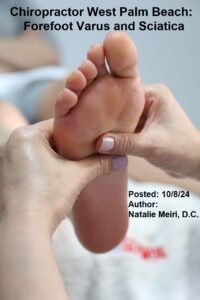
There is a common misconception that chiropractors are just “spine doctors”. However, from the very beginning, chiropractic adjustments have been delivered to the nonspinal joints as well. The nonspinal joints include the temporamandibular (TMJ), shoulder, elbow, wrist, hand, hip, knee, ankle and foot. For example, D.D. Palmer, the founder of the chiropractic profession described his treatment of the feet in 1910. In fact, applying manual procedures to the peripheral (nonspinal) joints is taught in all accredited chiropractic programs.
In this post, we explain about Chiropractor West Palm Beach: Forefoot Varus and Sciatica.
What is forefoot varus?
Sometimes a forefoot (front) varus (turned inward) deformity develops. It is an osseous (bony) structural abnormality in which the plantar (bottom) forefoot remains inverted (rolled inward) relative to the plantar rearfoot. And this is when the foot is in a neutral position. The condition causes some of the most severe overpronation problems. So pronation refers to the way your foot rolls inward for impact distribution upon landing.
A forefoot varus deformity is said to be congenital (condition present from birth). Research has postulated many reasons as to why infants develop a forefoot varus deformity. It is most likely the result of osseous abnormalities in the talonavicular and calcaneocuboid articulations (foot joints).
However, you can also have a functional forefoot varus. Here the forefoot appears inverted relative to the rearfoot, but this position is the result of soft tissue restriction. It is not a congenital osseous malalignment deformity.
In either case, the biomechanical defect present in the arch of the foot is the basic cause for many postural problems, back problems such as sciatica, and injuries of the lower extremity (limb).

How Sciatica Develops from a Forefoot Varus
Potential injuries associated with forefoot varus can cause postural affects due to excessive pronation of the foot. Excessive subtalar pronation causes the talus (bone that articulates with tibia/shin bone) to adduct (move toward midline) and plantar flex (move ankle to point toe downward) which results in excessive internal (inward) rotation. And as a result, this lowers the entire lower extremity. In a sense, this creates a functional short leg.
With the imbalance, tensile strain is put on the iliopsoas (a deep muscle group that connects the spine to the lower limbs) and piriformis muscles. And this leads to a narrowing of the greater sciatic notch (sciatic nerve exits pelvis here) in the pelvis. As a consequence, this predisposes to entrapment of the sciatic nerve.
Furthermore, as the lower extremity drops inferiorly (downward), the ipsilateral innominate (one of pelvic bones) is lowered. And this causes the body of the L5 vertebrae to rotate toward the “functionally shorted leg”. This can lead to compression of the spinal discs and the joints. Indeed, overuse injury will occur if not corrected leading to sciatica and other low back conditions.
Chiropractor West Palm Beach: Chiropractic Care for Forefoot Varus and Sciatica
Firstly, as mentioned previously, in a functional forefoot varus the forefoot appears inverted relative to the rearfoot. The culprit is the soft tissue restriction and not a congenital (a structural birth) deformity. In other words, the soft tissue contracture occurred over time.
Secondly, your Kinetic chain is a combination of several successively arranged joints, constituting a complex unit, as links in a chain. Chiropractic Manipulative Therapy should be delivered to the joints associated with both the forefoot varus and the sciatica. For example, adjustments to the lumbopelvic (low back and pelvis), ankle and foot joints.
Thirdly, stretching and strengthening exercises are important. Specifically, the muscles involved would be the peroneus longus (muscle in the lower leg that moves foot and ankle) and flexor hallucis brevis (big toe muscle) muscles to help stabilize the forefoot.
Fourthly, an orthotic may also provide additional support for a forefoot varus deformity. Certainly, a well designed shoe even without an orthotic has the ability to support the forefoot varus.

Treatment of Forefoot Varus at Meiri Chiropractic in West Palm Beach
As is the case with the spine, a detailed examination is necessary to determine the diagnosis and treatment plan for your forefoot varus and back condition. In addition to joint manipulation and adjustments to the extremity (limb) joints, at Meiri Chiropractic, we use soft tissue procedures, hot and cold modalities, stretching exercises, and rehabilitation exercises.
At Meiri Chiropractic in West Palm Beach we spend the time necessary to examine, diagnose and treat every neuromusculoskeletal condition and various ailments you have. Through regular chiropractic visits, you can get pain relief and improve function. Chiropractic is a holistic and natural way to not only treat existing conditions, but to keep your body in its best working condition. Meiri Chiropractic has been offering effective chiropractic care in Palm Beach County since 2006. Many of our patient reviews note our excellence. Call us today at 561-253-8984 in West Palm Beach to make an appointment or to find out more about Chiropractor West Palm Beach: Forefoot Varus and Sciatica.
References: Thomas Bergman, David Peterson, Chiropractic Technique Principles and Procedures, 3rd edition, 2011
Warren Hammer, Functional Soft Tissue Examination and Treatment by Manual Methods, 3rd edition